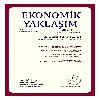An empirical study on the wage and price stickiness of us economy (1990-2009)
Abd ekonomisinde ücret ve fiyat yapışkanlığı üzerine ampirik bir çalışma (1990-2009)
___
- AKERLOF G.A., YELLEN J. (1985), "A Near-Rational Model of the Business Cycle, with Wage and Price Inertia", The Quarterly Journal of Economics, 100 (Supplement), 823-838.
- ALVES, N. (2004), "Nominal Wage Inertia In General Equilibrium Models", Banco de Portugal Economic Research Department, WP 15-04 September 2004.
- BARATTIERI A., BASU, S., GOTTSCHALK, P. (2010), "Some Evidence on the Importance.of Sticky Wages", NBER Working Paper No. 16130.
- BERNANKE, B.S., CAREY, K. (1996), "Nominal Wage Stickiness and Aggregate Supply in the Great Depression", NBER Working Paper No. 5439.
- BILLS, M., KLENOW P.J. (2002), "Some Evidence on the Importance of Sticky Wages" NBER Working Paper No. 9069.
- BORDO, M.D., ERCEG, C.J., EVANS C.L. (2000), "Money, Sticky Wages and the Great Depression" American Economic Review, Vol. 90, No. 5, 1447-1463.
- Bureau of Labor Statistics (BLS), www.bls.gov (February 2012).
- Bureau of Economic Analysis (BEA), www.bea.gov (February 2012).
- CHARI, V.V., KEHOE P.J., McGRATTAN, E.R. (2000), "Sticky Price Models of the Business Cycle: Can the Contract Multiplier Solve the Persistence Problem?" Federal Reserve Bank of Minneapolis Research Department Staff Report 217/JV.
- CHARI, V.V., KEHOE P.J., McGRATTAN, E.R. (2002), "Business Cycle Accounting", Federal Reserve Bank of Minneapolis Research Department Working Paper 625.
- CHRISTIANO, L.J., EICHENBAUM M., EVANS, C. L. (2005), "Nominal Rigidities and the Dynamic Effects of a Shock to Monetary Policy", The Journal of Political Economy, Vol. 113, No. 1, 1-45
- GORDON, R.J. (1981), "Price Inertia and Policy Ineffectiveness in the United States. 1890-1980" NBER Working Paper No. 744.
- GORDON, R.J. (1990), "What Is New Keynesian Economics?" Journal of Economic Literature, Vol. 28, September, 1115-71.
- GORDON, R.J. (2003), Macroeconomics, Boston: Addison Wesley.
- GREENWALD, B., STIGLITZ, J. (1993), "New and Old Keynesians", Journal of Economic Perspectives, Vol. 7, Winter, 23-44.
- HUANG, K.X.D., LIU Z., (2002), "Staggered Price-Setting, Staggered Wage-Setting and Business Cycle Persistence", Journal of Monetary Economics, Vol. 49, No. 405-433.
- LUCAS, R.E. Jr. (1973), "Some International Evidence on Output-Inflation Tradeoffs" American Economic Review, Vol. 63, No. 3, 326-334.
- MANKIW, N.G. (1985), "Small Menu Costs and Large Business Cycles: A Macroeconomic Model of Monopoly" Quarterly Journal of Economics, Vol. 100, No. 2, 529-538..
- MANKIW, N.G. (1990), "A Quick Refresher Course in Macroeconomics" Journal of Economic Literature, Vol. 28, December, 1645-1660.
- MANKIW, N.G. (1991), Comment on J J. Rotenberg and M. Woodford "Markups and the Business Cycle", NBER Macroeconomics Annual.
- MANKIW, N.G. (1992), "The Reincarnation of Keynesian Economics" European Economic Review, Vol. 36, April, 559-65.
- MANKIW, N.G., ROMER, D. (Eds.) (1991), New Keynesian Economics (2 vols), Cambridge, MA: MIT Press.
- SNOWDON, B„ VANE, H.R. (1995), "New Keynesian Economics Today: The Empire Strikes Back", The American Economist, Vol. 39, No. 1, 48-65.
- SNOWDON, B., VANE, H.R. (2005), Modern Macroeconomics: Its Origins, Development and Current State. Cheltenham UK: Edward Elgar Publishing Limited.
- TAYLOR, J.B. (1980), "Aggregate Dynamics and Staggered Contracts" The Journal of Political Economy, Vol. 88, No. 1, 1-23.
- TAYLOR, J.B. (1999), Staggered Price and Wage Setting in Macroeconomics. In J.B.Taylor & M. Woodford (Eds.), Handbook of Macroeconomics (Vol. 1, 1009-1050), Amsterdam: Elsevier B.V.
- ISSN: 1300-1868
- Yayın Aralığı: 3
- Yayıncı: Ekonomik Yaklaşım Derneği
Türkiye ekonomisi'nde dışa açılma ve teknolojik değişim: Büyük sanayi sermayesi örneği
Demet Özmen YILMAZ, Recep Koray YILMAZ
İktisat teorisinde unutulmuş bir kavram: "Mekân"
"Maliye"ye alternatif bir yaklaşım olarak mali sosyoloji: Öncüler
An empirical study on the wage and price stickiness of us economy (1990-2009)
Teşviklerin bölgesel ekonomik büyüme üzerindeki etkisi: Ampirik bir analiz
